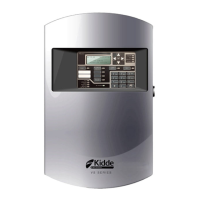Chapter 2: Front panel programming
P/N 3102351-EN • REV 005 • ISS 28DEC18 117
Description
When Standalone mode is selected Yes, and an SLC (loop) card loses
communication with the panel for more than 18 seconds, the SLC card will
enter standalone mode of operation. In this mode, the panel will:
• Enter standalone alarm mode if the determined “alarm” input is part of
standalone alarm configuration matrix.
• Perform loop startup, closing isolators, monitoring input (Query alarm
and Query status signature commands will be used for alarm
confirmation) and activating outputs during standalone alarm condition
• Not perform device startup, configuration or supervision operations.
Device supervision (involving hardware type, personality,
configuration, or mapping) is not performed during this mode.
• Not perform any find serial number or find new status operations so
that these statuses will remain available for use by the panel’s loop
controller code when communication restores.
• Trigger outputs and relay groups based on the configuration provided
by panel.
• Generate routine sync strobe Signature messages. Synchronization
will only be maintained on a per SLC card basis.
• Display a Loop Card Fault on the panel with a Communication Fault in
the details.
Note: Refer to “Device type descriptions” on page 49 for device types
supported by Standalone mode.
Save your option settings.
To program Panel Operation options:
1. Press the menu button and choose Program.
2. Choose Advanced Program.
3. Enter a level two password.
4. Choose Panel Operation.
5. Program the options using Table 35 on page 115.
Not all options shown in the table will be displayed on all systems.
6. When you finish programming each option, choose Save.
7. Press the Menu button to exit menu mode, or continue programming.
Event programming
Panel event programming
Panel events, such as reset, system startup, and battery low have an event notification setting
for contact ID, dialer, NET, and printer, which controls where the event is sent when it takes

